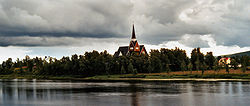Karesuando
| Karesuando | |
|---|---|

Karesuando Church in August 2005
|
|
| Coordinates: 68°26′28″N 022°28′44″E / 68.44111°N 22.47889°ECoordinates: 68°26′28″N 022°28′44″E / 68.44111°N 22.47889°E | |
| Country | Sweden |
| Province | Lapland |
| County | Norrbotten County |
| Municipality | Kiruna Municipality |
| Area | |
| • Total | 0.93 km2 (0.36 sq mi) |
| Population (31 December 2010) | |
| • Total | 300 |
| • Density | 324/km2 (840/sq mi) |
| Time zone | CET (UTC+1) |
| • Summer (DST) | CEST (UTC+2) |
Karesuando (Finnish: Kaaresuvanto or Karesuvanto, Sami: Karesuanto, Gárasavvon or Karasavvon) is the northernmost locality in Sweden. It is situated in Kiruna Municipality, Norrbotten County, Sweden, with 303 inhabitants in 2010 and 350 in 2011.
It is a church village of Sweden, located at the Muonio River on the border with Finland.
On the Finnish side of the river, the Finnish village of Karesuvanto is located (population about 140). According to Finnish tradition they are one and the same village (with a combined population of about 470), but they are usually considered different, since there is a national border between them (although both are called Karesuvanto in Finnish).
The village got its first buildings in 1670, when Måns Mårtensson Karesuando, called "Hyvä Maunu Martinpoika" in Finnish and "Good Maunu, Son of Martin" in English, bought land from Sami Henrik Nilsson Nikkas. The Lutheran vicar and botanist Lars Levi Laestadius served in Karesuando from 1826 to 1849. It was here that he founded the revivalist movement known to this day as Laestadianism.
The area is traditionally Finnish speaking, and the border was drawn for political reasons in 1809, not because of any cultural or any other border existing at that time. Later of course a cultural and language difference has grown because of school and church influence.
Karesuando is the northernmost point on European route E45.
...
Wikipedia


